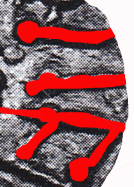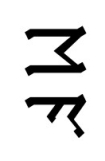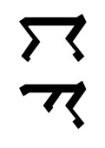Observations on the R8 and R8R sceatta images shown in the
"ITALO VECCHI LTD" sale catalogue of 1998.
I have recently purchased an old sale catalogue of the "William L Subjack Collection of Thrymsas and Sceattas 5th June 1998". The images of the 121 coins for sale are of very good quality. However, there are only two images of R8's, one of an R8 (77) and one of an R8R (79) sceatta. Scanning the images onto a computer and increasing the DPI considerably allows a very detailed inspection of both the Obverse and Reverse of the two coins to be carried out.
Image 78 is listed as an R8 but the symbols on the reverse don't look like a typical "R" as the Standard contains a Saltire with pellets. Abramsom catagorises this coin as "13. Saltire Standard (Secondary)" S/1/13/20 and quotes the source of his image as "Subjack 78". I have not included this coin in the research.

Subjack 77
The Runes in front of the head on Subjack 77 are shown in the image left.
The top of the "E" rune extends over the flan edge. There are no marks visible below either of the two top lines that would indicate a "P" rune. The top of the "A" runes also extends over the flan edge. This feature is not uncommon in the later "R" series coins


Subjack 77 image diagram
Subjack 77 is described in the catalogue as having the Runes PA before the head, I disagree with this. I consider them to be EA. On the coin (shown above) the base of the "E" (M) can be seen, the top (facing outward) extends over the flan edge. The very top of the "A" also extends over the flan edge. Although the standard on the reverse is quite offset making exact identification more difficult, it would appear to me to have a typical R8 reverse. No find spot was given in the description but the weight was recorded as 0.98g. No die axis given.
I have classified this coin as a Type 30, an R8/30. Type 30

The image left shows how runes "E" and "A" would appear on the Obverse of a Sceat.
The image right shows how the runes "P" and "A" would appear.

Pollington in Rudiments of Runelore 2011 p18 comments upon the shape of the ansuz rune (with sound value "a") changing shape and loosing the upward pointing end of the lower downward protruding arm. Evidence of this can be seen in the image above left (runes in red) where neither protruding arms of the lower "A" rune have an upward pointing end.
The formation of runes became stylised when depicted on the Sceat. Imagine cutting a die for a coin which was only 12mm in diameter with the available equipment in about AD 745, it can not have been a very exact science!
Subjack 79

Subjack 79 obv image diagram
Subjack 79 is described as an R8 but is an R8R variant of the R8 series. The obverse of this coin has a fairly usual configuration of symbols and runes. The runes "E" and "R" (read clockwise) are in front of the left facing head.
The coin information in the Italo Vecchi catalogue describes the symbols behind the head as "....ER in runes before radiate bust l., OAO behind." As I can see no evidence of a crown on the head I would describe the bust as Runic not Radiate. The "A" in between two annulets does not appear to be barred so I would describe this as a Horizontal Chevron. Again, as with the previously mentioned Subjack 77 coin, the top of the runes is either just over or very near the edge of the flan.
The Reverse of Subjack 79 is quite different from others I have seen. It has a large centrally placed beaded standard which extends to and sometimes over the flan edge. Only the top mid point cross pommée can be seen clearly. It would be usual for there to be one on each side of the standard. The central annulet within the standard is flanked by two "T's" above and two "L's" below. This is an unusual configuration of symbols/letters. See below.

Subjack 79 rev image diagram
Because of the "E" "R" clockwise configuration of runes and the horizontal chevron with an annulet both above and below it coupled with the usual stlye of Runic Bust head on the obverse this coin would be placed within the Type 240 to 249 types. The unusual configuration of symbols/letters on the reverse warrants a Type number of its own. No find spot is given but a weight of 0.77g and a die axis of 270° is recorded.
I have classified this coin as a Type 242, an R8R/242. Type 242




